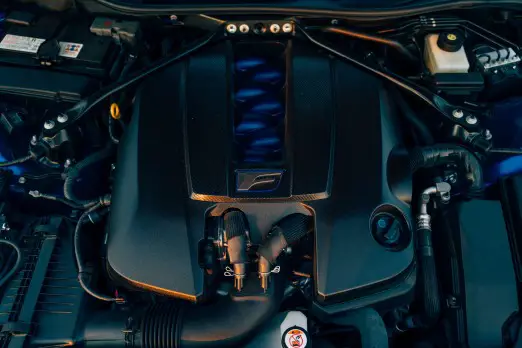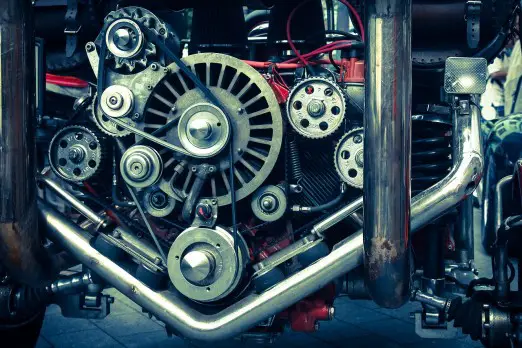The lifetime and smooth operation of an industrial gear system or a car’s transmission are dependent on gear oils. GL-4 and GL-5 are two of the most important classes, having been established by the American Petroleum Institute (API). Although these lubricants have certain similarities, they are designed with unique compositions to satisfy the unique requirements of various gear applications.
Importance of using the correct gear oil for optimal performance:
A vehicle’s gearbox or an industrial gear system’s lifetime and optimal performance depend heavily on the choice of gear oil. Specific additives and qualities are included in gear oils, such as those categorized under GL-4 and GL-5 requirements, to fulfil the demands of various applications. A variety of issues, such as heightened friction, quicker wear on gears and bearings, and reduced efficiency, can arise from using the incorrect gear oil. Such mismatches have repercussions that go beyond just sudden performance problems; they can lead to expensive maintenance and, eventually, a shortened system lifespan.

Understanding GL-4 and GL-5 Specifications:
The American Petroleum Institute (API) has specified two well-known classes for gear oils, GL-4, and GL-5, which are determined by the oils’ performance standards. It is vital to utilize the appropriate oil for certain applications since these requirements delineate the oil’s composition, additives, and performance attributes.
A. API Gear Oil Classifications:
- Classifications are established by the American Petroleum Institute to guarantee that gear oils meet consistent criteria.
- The letter GL stands for Gear Lubricant and the performance level is indicated by the number that follows.
B. Differences Between GL-4 and GL-5:
- Additive Packages:
- Additives appropriate for mild to moderate service conditions are used in GL-4 oil formulation.
- With a more robust additive package built to withstand harsh operating conditions, GL-5 lubricants offer improved protection against excessive pressures.
- Sulfur-Phosphorus Content:
- Because GL-4 oils usually have lower levels of sulfur-phosphorus compounds, they work well with yellow metals common in synchronizers, such as brass and bronze.
- Because GL-5 oils include more Sulphur and phosphorus, they may eventually corrode yellow metals.
C. Performance Characteristics:
- GL-4:
- provide lubrication in temperate weather.
- ideal for less intensely pressured synchronized manual transmissions.
- intended to keep ordinary gear systems safe from corrosion and wear.
- GL-5:
- provides exceptional protection in situations of large loads and intense pressure.
- Suggested for heavy-duty uses, such as commercial and off-road vehicles.
- increases the overall longevity of the gear system and thermal stability.
Compatibility Issues:
Understanding the differences between GL-4 and GL-5 gear oils is important for knowing their intended uses, but it is also important to be aware of any compatibility problems that could occur if you think about switching. Deviation from these criteria may negatively impact the overall performance and constituents of the gear system.
A. Impact on Synchronizers:
- GL-4 Specifics:
- Because GL-4 lubricants are made with less Sulphur and phosphorus, they may be used with yellow metals, such as those found in synchronizers.
- In manual gearboxes, GL-4 lubricants supply the lubrication required for synchronizers to engage smoothly without putting too much stress on them.
- GL-5 Concerns:
- GL-5 oils, with their higher sulfur-phosphorus content, may exhibit a corrosive effect on yellow metals.
- In applications with synchronizers, using GL-5 oil might accelerate wear and compromise the efficiency of gear engagement.
B. Yellow Metal Compatibility:
- GL-4 Advantage:
- Because GL-4 oils are designed to be less aggressive towards yellow metals, they are compatible with parts like brass and bronze that are frequently found in synchronizers for manual transmissions.
- GL-5 Caution:
- Because GL-5 lubricants are more resilient to high pressures, there may be a greater chance of corrosion acceleration for yellow metal parts.
- Using GL-5 in gear systems where yellow metals are present might cause early wear and jeopardise the component integrity.
C. Risk of Increased Wear and Tear:
- Mismatched Load Handling:
- Heavy loads and high-pressure scenarios are something that GL-5 oils are designed to withstand.
- It may be more likely to overlubricate and lose efficiency when GL-5 is used in situations where GL-4 is advised. This might result in higher wear on the gears and bearings.
- Potential Seal and Gasket Issues:
- The compatibility with seals and gaskets might be affected by the differences in the additive packages found in GL-4 and GL-5 lubricants.
- Inappropriate gear oil can weaken seals, which can cause leaks and less efficient lubrication.

Instances Where Substitution Might Be Acceptable:
While it is usually advised to follow manufacturer guidelines and use the suggested gear oil for a given application, there are several circumstances in which switching from GL-5 to GL-4 or vice versa may be considered appropriate. These situations often rely on particulars, the gear system’s makeup, and the operational environment.
A. Limited Stress and Load Conditions:
- GL-5 in GL-4 Applications:
- Using a GL-5 oil would not cause too many problems if the gear system runs in moderate circumstances with reduced stress and load requirements.
- This is especially true for passenger cars with manual gearboxes that are not used much.
- GL-4 in GL-5 Applications:
- On the other hand, if a car’s manual gearbox calls for GL-5 but is only used seldom, it may be okay to use GL-4 oil without sacrificing efficiency.
B. Mixed Fleet Scenarios:
- Compatibility Considerations:
- A balance may need to be found in mixed fleets when various cars or equipment have varied gear oil needs.
- For fleets with varying gear systems, several manufacturers provide gear oils with dual GL-4/GL-5 requirements.
C. Limited GL-5 Exposure to Yellow Metals:
- Selective Application:
- The danger of corrosion may be reduced if a gear system has limited contact with yellow metal components but needs GL-5 because of intense pressure conditions.
- The gear system’s composition must be carefully evaluated to estimate the level of exposure to yellow metals.
Manufacturer Recommendations:
It is important to follow the manufacturer’s instructions when choosing the proper gear oil for a car’s gearbox or gear system. These suggestions are meticulously customized to meet the unique needs of the machinery, accounting for elements like load capacity, gear composition, and operating circumstances. Disregarding these recommendations may result in less-than-ideal performance, more wear, and even damage to the gear system.
A. Referencing the Owner’s Manual:
- Primary Source of Information:
- The owner’s manual is a thorough handbook that comes from the manufacturer of the equipment or vehicle and provides specific instructions on lubrication, maintenance and suggested fluids.
- The handbook usually contains details on API classes (GL-4 or GL-5) and other special gear oil parameters.
- Understanding Gear System Requirements:
- The handbook helps users choose the right gear oil by offering insights into the specifications and design of the gear system.
B. OEM (Original Equipment Manufacturer) Guidelines:
- Tailored Recommendations:
- OEMs (Original Equipment Manufacturer) design gear systems with precise lubrication needs and have extensive understanding of their products.
- By adhering to OEM specifications, gear oil selection is guaranteed to complement the equipment’s intended lifespan and performance.
C. Considerations for Mixed Fleet Vehicles:
- Dual-Specification Gear Oils:
- Dual-specification gear oils that satisfy GL-4 and GL-5 regulations are offered by some manufacturers.
- These dual-specification oils could be a good middle ground in mixed fleet situations when cars have varying gear oil requirements.

Potential Benefits of Using GL-5 Gear Oil:
Gear oils are made to fulfil certain performance standards, and GL-5 is unique in that it is a designation intended to offer improved protection in extreme circumstances. Even though it is important to follow the manufacturer’s instructions, there are some situations when using GL-5 gear oil can be beneficial, especially in applications that are subjected to high pressure and large loads. The following are some advantages of using GL-5 gear oil:
A. Superior Extreme Pressure Protection:
- Designed for Heavy Loads:
- Gear oil with the GL-5 designation is specially designed to withstand high loads and pressure levels.
- The additive package in GL-5 lubricants offers excellent protection against wear in high-stress situations by preventing metal-to-metal contact with a strong lubricating coating.
B. Enhanced Thermal Stability:
- Operating at Higher Temperatures:
- Applications that frequently operate at elevated temperatures include differentials and gearboxes in heavy-duty trucks.
- Because GL-5 gear oils are designed to resist greater temperatures, they will provide consistent lubrication and guard against thermal breakdown even under extreme circumstances.
C. Extended Gear and Bearing Life:
- Reduced Wear and Tear:
- Superior extreme pressure additives in GL-5 gear oils help to save wear on gears and bearings by reducing friction.
- An expected result might be longer component life, particularly in situations where strong loads and continuous operation are typical.
D. Compatibility with Hypoid Gears:
- Ideal for Hypoid Gear Arrangements:
- Applications utilizing hypoid gear configurations, which are frequently seen in rear axles, are a good fit for GL-5 gear oils.
- The composition is made to effectively lubricate hypoid gears, guaranteeing their durability and smooth operation.
E. Resistance to Oxidation and Corrosion:
- Protecting Against Environmental Factors:
- Additives that improve resistance to oxidation and corrosion are frequently included in GL-5 oils.
- When gear systems are exposed to dampness, fluctuating temperatures, and other external conditions, this resilience is especially helpful.
F. Versatility Across Applications:
- Applicability in Various Systems:
- GL-5 gear oils are multipurpose and may be used in heavy-duty industrial machinery as well as off-road vehicles.
- Because of its adaptability, GL-5 is the recommended option in situations requiring a higher degree of protection and performance.
G. Improved Load-Carrying Capacity:
- Handling Heavy Loads:
- Because GL-5 lubricants are designed to withstand larger loads, they can be used in situations where the gear system is exposed to significant weight or torque.
- The improved load-carrying capability adds to the gear system’s overall robustness and dependability.
Frequently asked questions:
Can I utilize GL-5 rather than GL-4?
It may be appropriate in certain circumstances to use GL-5 gear oil rather than GL-4, particularly in applications with higher weights and harsher environments.
Does GL-5 support GL-4 backwards compatibility?
Backward compatibility with GL-4 is normally supported by GL-5 gear oil, but care must be taken, particularly regarding yellow metal components.
What does GL-4 gear oil look like?
The normal color of GL-4 gear oil is transparent to amber. Depending on the precise composition and additives used by various producers, its visual qualities may change.
Is GL-5 suitable for use in a gearbox?
Gearboxes can use GL-5, however, there may be compatibility problems; this is especially true with yellow metals.
Conclusion:
To sum up, selecting between GL-4 and GL-5 gear oils is still essential to preserving the longevity and best performance of gear systems. Even if GL-4 and GL-5 have different uses, it is important to know their features, compatibility problems, and advantages to make wise choices. It is important to follow manufacturer guidelines and get expert guidance to reduce the hazards that come with using the wrong gear oil. While GL-5 gear oil provides higher thermal stability and severe pressure protection, its application should be dictated by the requirements of the gear system to strike a compromise between better performance and equipment design compatibility. In the end, protecting the effectiveness and lifespan of various gear applications requires a thoughtful approach to gear oil choosing.

